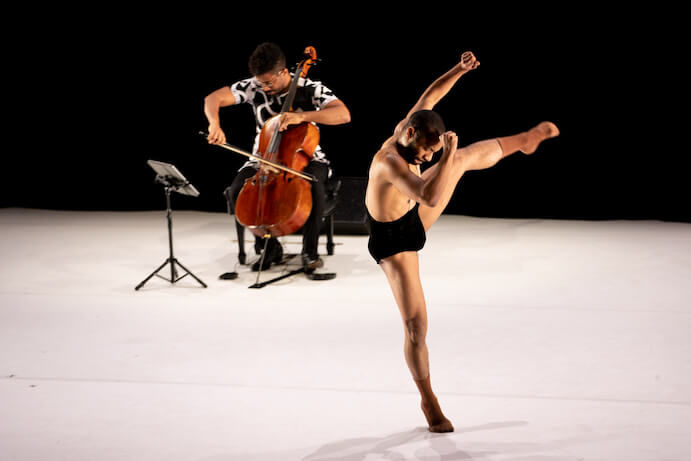Through striking multimedia performance, cellist Seth Parker Woods is highlighting the synergistic possibilities when different artistic mediums cross paths. Difficult Grace, presented on December 4 by UCLA’s Center for the Art of Performance, featured Woods in the role of cellist and narrator, accompanied by dance, film, visual artwork, and spoken text. While a pared down version of the program premiered in Seattle in February 2020, this new version brings in dancer Roderick George as a skillful collaborator who ties the visual and sonic elements together with his original choreography. Connectivity is the ultimate throughline of the program — Woods bridges multiple artistic disciplines, styles, and artists, while also bringing meaningful historical narratives to the audience.
Difficult Grace is steeped in the richness of Black history and culture, which manifests aurally and thematically in each of the carefully curated works on the program. Ted Hearne’s Freefucked, featuring poetry by Kemi Alabi, includes rhythms in the electronic accompaniment that are reminiscent of hip hop. Coleridge-Taylor Perkinson’s “Calvary Ostinato” from Lamentations: Black/Folk Song Suite for Solo Cello encompasses an array of sounds drawn from the Black diaspora; brief, weighty glissandos and twangy pizzicato link the influences of jazz, blues, country, and folk musics.
Seth Parker Woods presents Difficult Grace–Photo by Bailey Holiver
Described as a “semi-autobiographical exploration of identity,” Difficult Grace draws inspiration from the Great Migration — a mass exodus of approximately six million Black people from the Southern United States to the burgeoning, fast-paced cities of the Northeast, Midwest, and West in the early to mid 20th century. Drawing on the cultural tensions of immigration and domestic migration, as well as relics in Black culture such as the groundbreaking Black-owned newspaper, The Chicago Defender, Woods contextualizes his contemporary experiences as a Black man in America.
These aspects were especially prominent in Nathalie Joachim’s The Race: 1915, which featured a narrative-rich backdrop of text from The Chicago Defender and images from “The Migration Series” — an in-depth look at Jacob Lawrence’s paintings inspired by the Great Migration. The influence of the Great Migration was reflected in fierce, restless melodies that buzzed by. The foil to these hurried sections were gentler ones, perhaps representative of the peace many were seeking by fleeing the South. Woods embodied this sense of dichotomy in his performance; he was nimble yet spirited in the swift moments, while also capturing the tenderness of the tranquil passages. The most straightforward of the works on the program, The Race: 1915 leaves little to the imagination while sidestepping the pitfall of being too on the nose. The work is immensely successful in blending factual historical narratives with musical creativity.
Seth Parker Woods presents Difficult Grace–Photo by Bailey Holiver
A cello sonata by British composer and multi-instrumentalist Devonté Hynes tied in more classical elements to a concert that shapeshifted into different genres at every turn, and the performance concluded with Pierre Alexandre Tremblay’s feverish work asinglewordisnotenough 3 [invariant]. The duet between Woods and George bursted with vivid energy as Woods attacked each note with a biting intensity. George demonstrated a vast breadth of capability in translating intricate musical details into movement throughout the program — a trend which culminated in this powerful final offering. The two were adept collaborators who shared the stage with equal virtuosity and control.
Difficult Grace posed the daunting task of intertwining a complex past with a developing present. Ultimately, the project accomplishes this delicate balance through a multidisciplinary approach. With music at its core, each artistic medium on the program complements the others. The program’s intention to highlight underrepresented voices is in line with its central message of bringing perspectives together to explore the concept of identity. Many of the pieces were written for or with Woods and featured composers, poets, and visual artists of color. Through Difficult Grace, Woods has proven himself to not only be a remarkable musician, but a capable and well-rounded curator as well.
I CARE IF YOU LISTEN is an editorially-independent program of the American Composers Forum, and is made possible thanks to generous donor and institutional support. Opinions expressed are solely those of the author and may not represent the views of ICIYL or ACF.
You can support the work of ICIYL with a tax-deductible gift to ACF. For more on ACF, visit the “At ACF” section or composersforum.org.

